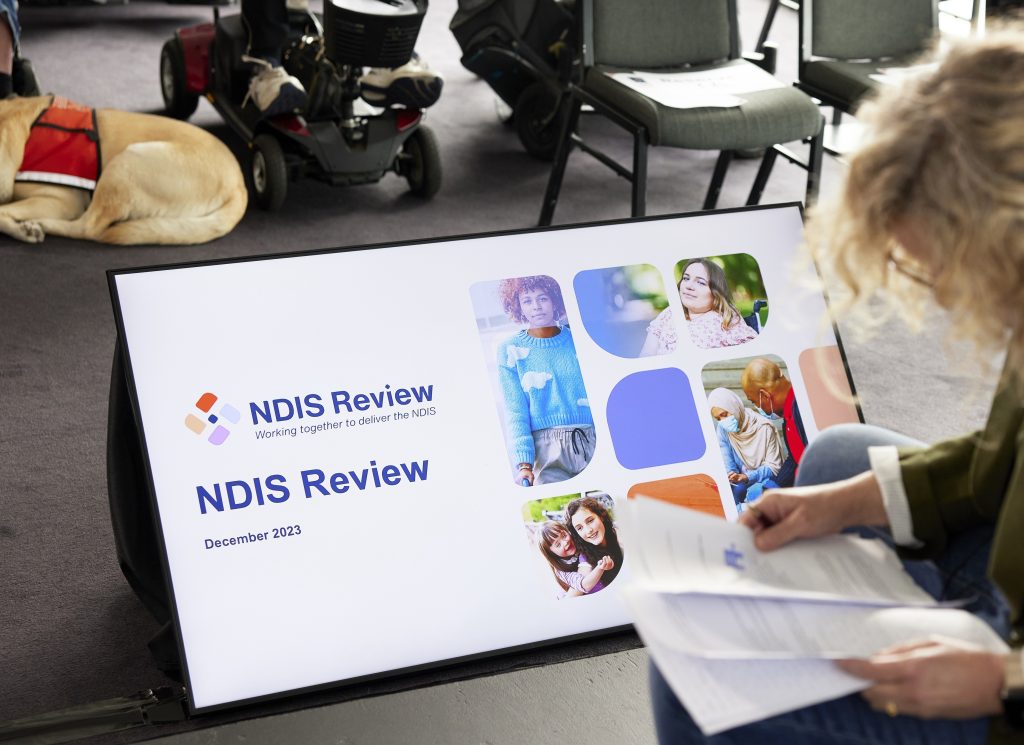Access and budgets: the NDIS Review explained
I’ve spent the summer travelling around the country, hosting discussions with the NDIS Review panel where people with disability heard first-hand about the proposed changes. I’m going to capture some of the ideas sparked in those discussions and share my own reflections in this series.

A screen displaying “NDIS Review, December 2023”. A support dog is asleep in the background and a blonde woman is reading notes in the foreground.
People with disability know all about access. Whether it’s a public building, a workplace or a nightclub, the little decisions people make can have a profound impact on our experience.
I once turned up for my first day at a new job to discover that my team was located upstairs, along with the kitchen and toilets. No one had bothered to tell me I’d be physically separated from everyone at any time during the recruitment process!
The same goes for the NDIS and the convoluted processes that have been put between people with disability and the support they need: it’s like a whole system that has steps rather than ramps and a heavy door at the end, which is incredibly difficult to open.
There are two specific barriers that make getting into the scheme feel near-impossible.
The first is the assessment process. It’s really hard to navigate; to just get started on the process for my plan, I first needed to find a GP who understood how to fill in the access form. Never has a form created so much confusion and anxiety.
Of course, the NDIS then lost my access form for 7 months before it was approved. Needless to say, the system is full of cracks.
Like any good accessibility audit, the Review has come up with a living process rather than a policy to be adopted and filed away.
First, we need to make the process work in favour of the applicant, not against them. That means simplifying the access form and making sure that if the NDIS needs more info from your doctors or specialists, they foot the bill. This is a big deal because right now, if you can afford all those assessments, you’re more likely to get what you need compared to those who can’t.
The next step is to make sure you get the supports you need once you’ve been approved. Once you’re in, according to the Review’s suggestions, your budget will mostly be decided by NDIA planners who sit down with you during planning meetings and really understand your needs.
This is a big change from the way things have been, where you’d chat on the phone with local contractors (LACs) who pass your case along to someone who never even meets you to figure out your plan and budget.
According to the Review Panel, budgets will be based on an assessment of what support you need, with input from your doctors, specialists, and family if you want them involved. The hope is that this will bring some consistency and fairness to the whole process, which has been seriously lacking. If folks know what to expect from these meetings and how it’ll all shake out, maybe it’ll be less stressful. Fingers crossed!
Third, once you are in the Scheme, you will not have to keep re-proving your disability and funding needs. If you’re happy with what you’ve got and it’s working well, why not let it ride for more than just 12 months? It’s a smart move to save both people with disability and the NDIA a bunch of hassle.
One of the things that struck me as we held our briefings was the ongoing suspension of assessment processes.
After all, we fought hard against the automated Independent Assessments proposed by the previous government. This means that there is a high bar on making the case for any move that detracts from the individual experience of a person with disability.
The big difference in this proposal is that while Independent Assessments purported to determine your level of function via an algorithm, this process involves a real person assessing your actual support needs.
The way this occurs should be built from the ground up with input from the people who rely on the scheme and the organisations that represent them.
Like any good accessibility audit, perspective is critical. Unless you are seeing the barriers in front of you, you will never work out ways to get around them.
And action is critical, it’s all well and good to have the solutions on paper but putting them into action is where accessibility becomes reality.
After all, we’ve heard promises of smoother access and budgeting before, so the real test will be how all these ideas are rolled out. We’ll definitely be keeping an eye on it.
Latest Ideas
- Who Benefits? Unpacking International Day of People with Disability
- “The Assembly” misses the mark: here’s how I’d get it back on track
- No place like home: the fight for accessible housing in Australia
- Be afraid, wheelchairs on a plane
- Blazing the Trail – how CPActive is transforming NSW Public Sector Employment for People with Disabilities
Send us your idea
Send an outline to us by email at: info@disabilitydialogue.com.au. Please attach any supporting documents or images. Thanks for your contribution – we will contact you via email.

